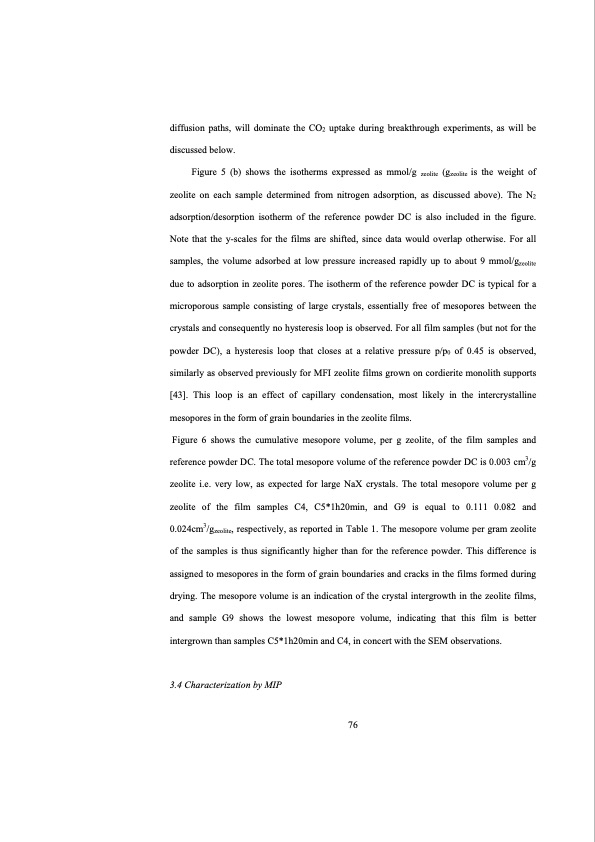
PDF Publication Title:
Text from PDF Page: 092
diffusion paths, will dominate the CO2 uptake during breakthrough experiments, as will be discussed below. Figure 5 (b) shows the isotherms expressed as mmol/g zeolite (gzeolite is the weight of zeolite on each sample determined from nitrogen adsorption, as discussed above). The N2 adsorption/desorption isotherm of the reference powder DC is also included in the figure. Note that the y-scales for the films are shifted, since data would overlap otherwise. For all samples, the volume adsorbed at low pressure increased rapidly up to about 9 mmol/gzeolite due to adsorption in zeolite pores. The isotherm of the reference powder DC is typical for a microporous sample consisting of large crystals, essentially free of mesopores between the crystals and consequently no hysteresis loop is observed. For all film samples (but not for the powder DC), a hysteresis loop that closes at a relative pressure p/p0 of 0.45 is observed, similarly as observed previously for MFI zeolite films grown on cordierite monolith supports [43]. This loop is an effect of capillary condensation, most likely in the intercrystalline mesopores in the form of grain boundaries in the zeolite films. Figure 6 shows the cumulative mesopore volume, per g zeolite, of the film samples and reference powder DC. The total mesopore volume of the reference powder DC is 0.003 cm3/g zeolite i.e. very low, as expected for large NaX crystals. The total mesopore volume per g zeolite of the film samples C4, C5*1h20min, and G9 is equal to 0.111 0.082 and 0.024cm3/gzeolite, respectively, as reported in Table 1. The mesopore volume per gram zeolite of the samples is thus significantly higher than for the reference powder. This difference is assigned to mesopores in the form of grain boundaries and cracks in the films formed during drying. The mesopore volume is an indication of the crystal intergrowth in the zeolite films, and sample G9 shows the lowest mesopore volume, indicating that this film is better intergrown than samples C5*1h20min and C4, in concert with the SEM observations. 3.4 Characterization by MIP 76PDF Image | Structured Zeolite Adsorbents for PSA Applications

PDF Search Title:
Structured Zeolite Adsorbents for PSA ApplicationsOriginal File Name Searched:
structured-zeolites.pdfDIY PDF Search: Google It | Yahoo | Bing
CO2 Organic Rankine Cycle Experimenter Platform The supercritical CO2 phase change system is both a heat pump and organic rankine cycle which can be used for those purposes and as a supercritical extractor for advanced subcritical and supercritical extraction technology. Uses include producing nanoparticles, precious metal CO2 extraction, lithium battery recycling, and other applications... More Info
Heat Pumps CO2 ORC Heat Pump System Platform More Info
| CONTACT TEL: 608-238-6001 Email: greg@infinityturbine.com | RSS | AMP |